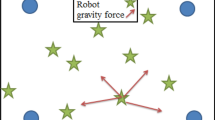Abstract
Multi-robot task allocation (MRTA) is the basis of a multi-robot system to perform tasks automatically, which directly affects the execution efficiency of the whole system. A distributed cooperative task allocation strategy based on the algorithm of the improved Grey Wolf Optimizer (IGWO) was proposed to quickly and effectively plan the cooperative task path with a large number of working task points. The MRTA problem was transformed into multiple traveling salesman problems (MTSPs), and the task target points were clustered by the K-means clustering algorithm and divided into several traveling salesman problems (TSPs). The Grey Wolf Optimizer (GWO) was improved by the Kent chaotic algorithm to initialize the population and enhance the diversity of the population. Furthermore, an adaptive adjustment strategy of the control parameter \(\vec {a}\) was proposed to balance exploration and exploitation. The individual speed and position updates in PSO were introduced to enable the gray wolf individual to preserve its optimal location information and accelerate the convergence speed. The IGWO was used to solve the optimal solutions to multiple TSP problems. Finally, the optimal solution space was integrated to get the optimal solution of MTSP, and 16 international classical test functions simulated the IGWO. The results showed that the IGWO algorithm has faster convergence speed and higher accuracy. The task allocation strategy is reasonable, with roughly equal path length, small planning cost, fast convergence speed, and excellent stability.












Similar content being viewed by others
Explore related subjects
Discover the latest articles and news from researchers in related subjects, suggested using machine learning.References
Arora P, Deepali D, Varshney S (2016) Analysis of k-means and k-medoids algorithm for big data. Procedia Comput Sci 78:507–512
Das S, Biswas A, Dasgupta S, Abraham A (2009) Bacterial foraging optimization algorithm: theoretical foundations, analysis, and applications. Found Comput Intell Spring 3:23–55
Dorigo M, Birattari M, Stutzle T (2006) Ant colony optimization. IEEE Comput Intell Magazine 1(4):28–39
Jiang H, Wang XY, Wang FY, Li J (2018) Study of perimeter security signal recognition based on PSO-GWO-SVM. Laser Infrared 48:396–400
Kaveh A, Zakian P (2018) Improved GWO algorithm for optimal design of truss structures. Eng Comput 34:685–707
Konak A, Coit DW, Smith AE (2006) Multi-objective optimization using genetic algorithms: a tutorial. Reliabil Eng Syst Safe 91(9):992–1007
Liu JJ, Shi D, Wu G (2015) Hybrid chaotic optimization algorithm based on Kent map. Comput Eng Design 36:1498–1503
Liu WB, Wang YD (2019) Path planning of multi-UAV cooperative search for multiple targets. Electron Opt Control 26(03):35–38
Long W, Cai S, Jiao J, Wu T (2019) An improved Grey Wolf Optimization algorithm. ACTA electonica sinica 47:169–175
MathWorks(2019). Hybrid GWOPSO optimization. https://www.mathworks.com/matlabcentral/fileexchange/68776-hybrid-gwopso-optimization Accessed 10 May 2019
Mirjalili S, Lewis A (2016) The whale optimization algorithm. Adv Eng Softw 95:51–67
Mirjalili S, Mirjalili SM, Lewis A (2014) Grey Wolf Optimizer. Adv Eng Softw 69:46–61
Mittal N, Singh UM, Sohi BS (2016) Modified grey wolf optimizer for global engineering optimization. Applied computational intelligence and soft computing. Hindawi Limited, London, pp 197–212
Qin X, Zong Q, Li X, Zhang B, Zhang X (2018) Task allocation of multi-robot based on improved ant colony algorithm. Aerospace Control Appl 44:58–62
Tang F, Parker LE (2005) ASyMTRe: automated synthesis of multi-robot task solutions through software reconfiguration. In: Proceedings of the 2005 IEEE International Conference on Robotics and Automation, IEEE, pp. 1501–1508.
Trelea IC (2003) The particle swarm optimization algorithm: convergence analysis and parameter selection. Inf Process Lett 85(6):317–325
Wang Q, Wang M, Wang X (2019) Improved grey wolf optimizer with convergence factor and proportional weight. Comput Eng Appl 55(21):60–65
Zainal N, Zain AM, Sharif S (2015) Overview of artificial fish swarm algorithm and its applications in industrial problems. Appl Mech Mater 815:253–257
Zhang D, Xie G, Yu J, Wang L (2005) An adaptive task assignment method for multiple mobile robots via swarm intelligence approach. In: 2005 International Symposium on Computational Intelligence in Robotics and Automation, IEEE, pp. 415–420
Zhang X, Li J, Xing J, Wang P, Yang Q (2016) A Kent chaos artificial bee colony algorithm based wavelet thresholding for high-rise structure vibration signal denoising. J Build Struct 37:467–474
Zlot R, Stentz A (2005) Complex task allocation for multiple robots. In: Proceedings of the 2005 IEEE International Conference on Robotics and Automation, IEEE, pp. 1515–1522
Funding
This work was supported by Key Supporting Project of the Joint Fund of the National Natural Science Foundation of China (No. U1813222), Tianjin Natural Science Foundation (No. 18JCYBJC16500) and Hebei Province Natural Science Foundation (No.E2016202341).
Author information
Authors and Affiliations
Contributions
JL conceived of and designed the experiments and wrote the paper. FY gave some comments for the work and helped revise the paper and improve the writing.
Corresponding author
Ethics declarations
Conflict of interest
The authors declare no conflict of interest.
Additional information
Publisher's Note
Springer Nature remains neutral with regard to jurisdictional claims in published maps and institutional affiliations.
Rights and permissions
About this article
Cite this article
Li, J., Yang, F. Task assignment strategy for multi-robot based on improved Grey Wolf Optimizer. J Ambient Intell Human Comput 11, 6319–6335 (2020). https://doi.org/10.1007/s12652-020-02224-3
Received:
Accepted:
Published:
Issue Date:
DOI: https://doi.org/10.1007/s12652-020-02224-3




